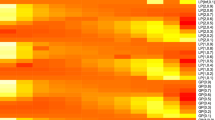Abstract
In this contribution, we mainly investigate how new entropy and cross entropy measures of hesitant fuzzy linguistic term sets (HFLTSs) can be designed by using the counterparts proposed for linguistic term sets (LTSs). In this circumstance, we intend to point out some drawbacks of the existing entropies, and then extend the theory of entropy and cross entropy measures of HFLTSs by constructing a number of new entropies. Furthermore, we compare the results of the approach being proposed based on the new entropy and cross entropy measures with that of the weight-determining method and the hesitant fuzzy linguistic alternative queuing method (HFL-AQM).
Similar content being viewed by others
References
Bordogna G, Passi G (1993) A fuzzy linguistic approach generalizing boolean information retrieval: a model and its evaluation. J Amer Soc Inform Sci 44:70–82
Capuano N, Chiclana F, Fujita H, Herrera-Viedma E, Loia V (2017) Fuzzy group decision making with incomplete information guided by social influence. IEEE Trans Fuzzy Syst, 99. https://doi.org/10.1109/TFUZZ.2017.2744605
Chang P, Chen Y (1994) A fuzzy multi-criteria decision making method for technology transfer strategy selection in biotechnology. Fuzzy Sets Syst 63:131–139
Chen SM, Hong JA (2014) Multi-criteria linguistic decision making based on hesitant fuzzy linguistic term sets and the aggregation of fuzzy sets. Inform Sci 286:63–74
Degani R, Bortolan G (1988) The problem of linguistic approximation in clinical decision making. Int J Approx Reason 2:143–162
Delgado M, Verdegay JL, Vila MA (1993) Linguistic decision making models. Int J Intell Syst 7:479–492
Farhadinia B (2016) Determination of entropy measures for the ordinal scale-based linguistic models. Inform Sci 369:63–79
Farhadinia B (2016) Multiple criteria decision-making methods with completely unknown weights in hesitant fuzzy linguistic term setting. Knowl-Based Syst 93:135–144
Farhadinia B (2013) Information measures for hesitant fuzzy sets and interval-valued hesitant fuzzy sets. Inform Sci 240:129–144
Farhadinia B (2014) A series of score functions for hesitant fuzzy sets. Inform Sci 277:102–110
Farhadinia B (2014) Distance and similarity measures for higher order hesitant fuzzy sets. Knowl-Based Syst 55:43–48
Gou X, Xu ZS, Liao H (2017) Hesitant fuzzy linguistic entropy and cross-entropy measures and alternative queuing method for multiple criteria decision making. Inf Sci. https://doi.org/10.1016/j.ins.2017.01.033
Hao Z, Xu ZS, Zhao H, Fujita H (2017) A dynamic weight determination approach based on the intuitionistic fuzzy bayesian network and its application to emergency decision making. IEEE Trans Fuzzy Syst, 99. https://doi.org/10.1109/TFUZZ.2017.2755001
Law CK (1996) Using fuzzy numbers in educational grading system. Fuzzy Sets Syst 83:311–323
Lee H (1996) Group decision making using fuzzy sets theory for evaluating the rate of aggregative risk in software development. Fuzzy Sets Syst 80:261–271
Liao HC, Xu ZS (2014) Satisfaction degree based interactive decision making under hesitant fuzzy environment with incomplete weights. Int J Uncertainty Fuzziness Knowl-Based Syst 22:553–572
Liao HC, Xu ZS, Zeng XJ (2014) Distance and similarity measures for hesitant fuzzy linguistic term sets and their application in multi-criteria decision making. Inform Sci 271:125–142
Liao HC, Xu ZS, Zeng XJ, Merigo JM (2014) Qualitative decision making with correlation coefficients of hesitant fuzzy linguistic term sets. Knowl-Based Syst. In press
Liu HB, Cai JF, Jiang L (2014) On improving the additive consistency of the fuzzy preference relations based on comparative linguistic expressions. Int J Intell Syst 29:544–559
Liu HB, Rodriguez RM (2014) A fuzzy envelope of hesitant fuzzy linguistic term set and its application to multi-criteria decision making. Inform Sci 258:220–238
De Luca A, Termini S (1972) A definition of a non-probabilistic entropy in the setting of fuzzy sets. Inf Control 20:301–312
Rodriguez RM, Liu HB, Martinez L (2014) A fuzzy representation for the semantics of hesitant fuzzy linguistic term sets. Found Intell Syst Adv Intell Syst Comput 277:745–757
Rodriguez RM, Martinez L, Herrera F (2013) A group decision making model dealing with comparative linguistic expressions based on hesitant fuzzy linguistic term set. Inform Sci 241:28–42
Rodriguez RM, Martinez L, Herrera F (2012) Hesitant fuzzy linguistic terms sets for decision making. IEEE Trans Fuzzy Syst 20:109–119
Shang XG, Jiang WS (1997) A note on fuzzy information measures. Pattern Recogn Lett 18:425–432
Torra V (2010) Hesitant fuzzy sets. Int J Intell Syst 25:529–539
Wei CP, Zhao N, Tang XJ (2014) Operators and comparisons of hesitant fuzzy linguistic term sets. IEEE Trans Fuzzy Syst 22:575–585
Wu J, Dai L, Chiclana F, Fujita H, Herrera-Viedma E (2018) A minimum adjustment cost feedback mechanism based consensus model for group decision making under social network with distributed linguistic trust. J Inf Fus 41:232–242
Xu ZS (2012) Linguistic decision making: theory and methods. Science Press, Beijing
Xu ZS, Xia MM (2012) Hesitant fuzzy entropy and cross-entropy and their use in multiattribute decision-making. Int J Intell Syst 27:799–822
Yager RR, Goldstein LS, Mendels E (1994) FUZMAR: an approach to aggregating market research data based on fuzzy reasoning. Fuzzy Sets Syst 68:1–11
Zhu B, Xu ZS (2014) Consistency measures for hesitant fuzzy linguistic preference relations. IEEE Trans Fuzzy Syst 22:35–45
Zhao N, Xu ZS, Liu F (2015) Uncertainty measures for hesitant fuzzy information. Int J Intell Syst 30:818–836
Author information
Authors and Affiliations
Corresponding author
Rights and permissions
About this article
Cite this article
Farhadinia, B., Xu, Z. Novel hesitant fuzzy linguistic entropy and cross-entropy measures in multiple criteria decision making. Appl Intell 48, 3915–3927 (2018). https://doi.org/10.1007/s10489-018-1186-2
Published:
Issue Date:
DOI: https://doi.org/10.1007/s10489-018-1186-2




